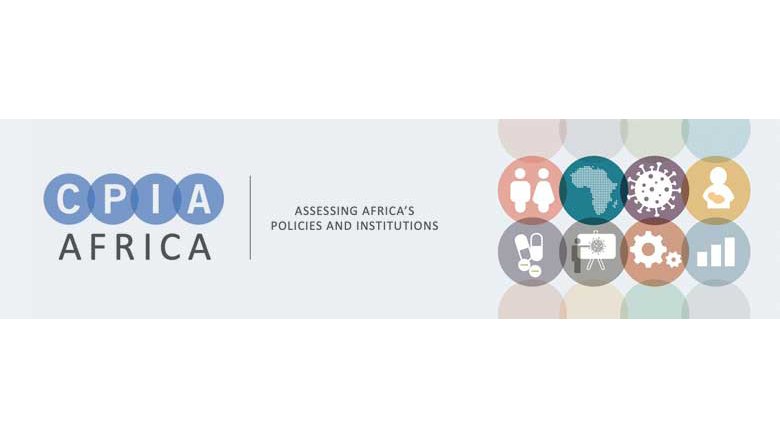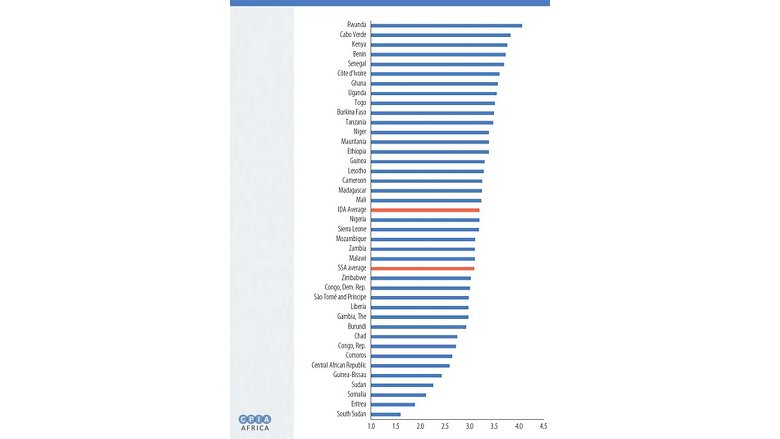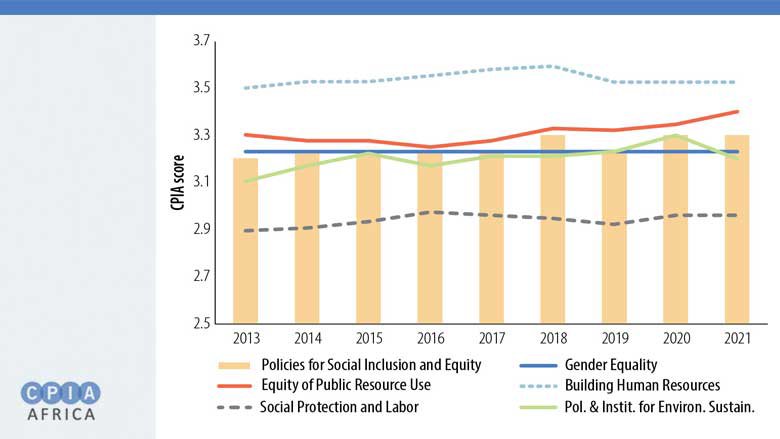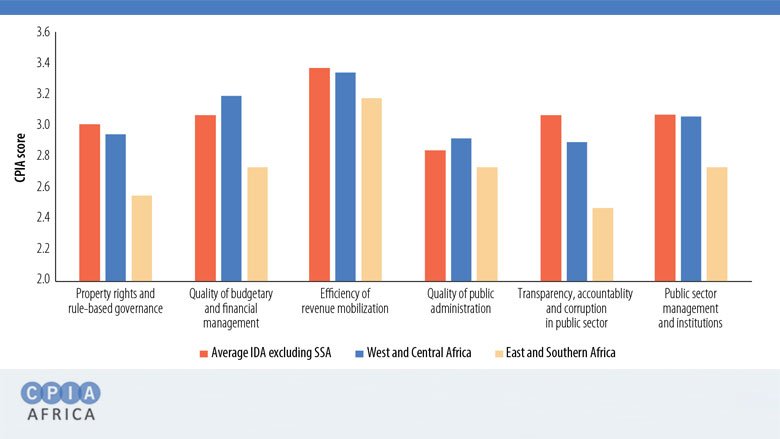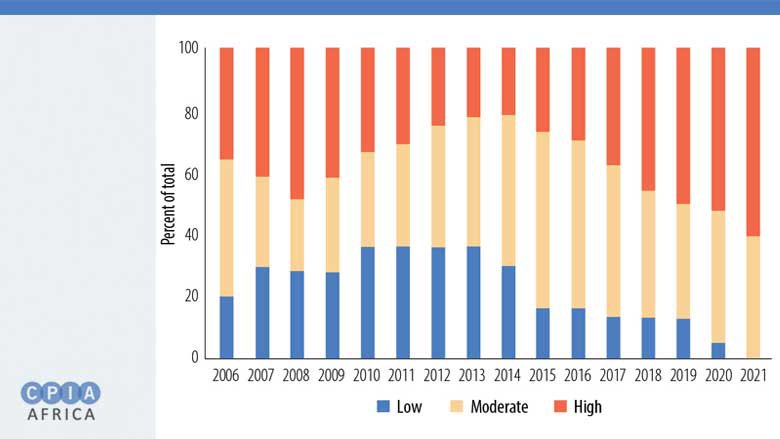The Country Policy and Institutional Assessment (CPIA) for Africa is an annual diagnostic tool for Sub-Saharan African countries eligible for financing from the International Development Association (IDA), the part of the World Bank that helps the world’s poorest countries. The 2022 CPIA Report measures each country’s quality of policies and institutional frameworks, and ability to support sustainable growth and poverty reduction, covering the year from January to December 2021. The report provides scores for 16 criteria for each country and an overall regional score on a scale of 1 (lowest) to 6 (highest), in four areas: economic management, structural policies, social inclusion and equity policies, and public sector management and institutions.
The scores inform governments of the impact of the country’s efforts to support favorable growth and poverty reduction. The overall score helps determine the size of the World Bank’s concessional lending and grants to low-income Sub-Saharan African countries. The report includes scores for 39 IDA-eligible countries.
Here are the top five highlights from the 2022 Africa CPIA:
Rwanda leads for the seventh year in a row with an overall CPIA score of 4.1
Rwanda maintained its highest CPIA score of 4.1, leading rankings for the seventh year in a row. Kenya improved slightly with an average score of 3.8, joining Cabo Verde with its unchanged score of 3.8. Benin and Senegal follow, with an average score of 3.7. Benin upgraded its CPIA score in 2021 from 3.6.
The overall average score for Sub-Saharan Africa’s IDA-eligible countries remained unchanged in 2021 at 3.1. Similarly, no changes were observed at the subregional level, where the scores were constant at 3.2 for West and Central Africa and 3.0 for East and Southern Africa. At the country level, the overall CPIA scores changed in 11 countries in 2021, the overall average CPIA score increased in seven countries and fell in four countries. Countries with average scores below 3.0 are mostly classified as those operating in fragile and conflict situations, with the notable exception of São Tomé and Príncipe.
Overall CPIA Score of Sub-Saharan African Countries (IDA), 2021
Social inclusion and equity policies contributed to higher scores
The overall average CPIA score for 2021 increased in seven countries (Benin, Kenya, Mauritania, Sierra Leone, Somalia, South Sudan, and Sudan). Among these countries, 70% improved their performance in policies for social inclusion and equity. However average scores for social inclusion and equity in the region overall remained unchanged. Improvements in the equity of public resource use was offset by the decline in the score for policies and institutions for environmental sustainability.
Trends in the Average Scores for Social Inclusion and Equity
Management of the economy in Sub-Saharan Africa has improved
The average score for economic management edged up in 2021 to 3.2, from 3.1 in the previous year. The upward revision reflects improved monetary and exchange rate policies. Monetary and exchange rate policy was essential in dealing with inflationary pressures without jeopardizing the recovery process and keeping public debt sustainable. Inflationary pressures were contained in the West and Central Africa subregion owing to the fixed exchange rate regime prevailing in the common currency of West African Economic and Monetary Union (WAEMU) countries and Central African Monetary and Economic Community (CEMAC) countries.
Trends in Economic Management Cluster Scores over Time
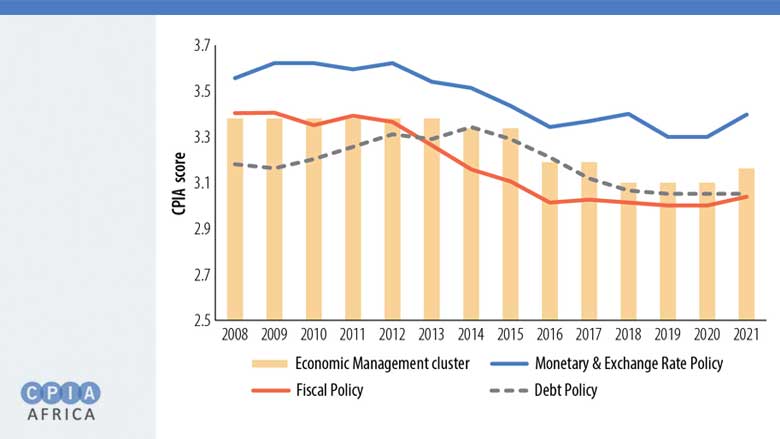
However, public sector management and institutions remain weak
The regional average public sector management score was 2.8 in 2021, unchanged from the last two years. However, AFW’s average score for public sector management and institutions was higher than the average score for countries in AFE and close to the average score for IDA countries around the world. AFE countries led all IDA countries, including those in other regions, on budgetary and financial management and the quality of public administration.
Comparison of Sub-Saharan Africa’s Public Sector Governance Performance with that of other IDA countries
And debt vulnerabilities have grown considerably over time
Debt vulnerabilities have increased significantly in the region—with the combination of weak growth prospects, tightening financial conditions, weaker currencies, and widened sovereign spreads. In 2021, IDA-eligible countries in the region were at moderate or high risk of debt distress, and the share of countries at high risk of debt distress grew from 52.6% in 2020 to 60.5% in 2021.
Given the elevated debt levels and growing number of IDA countries in high or moderate risk of debt distress, aggressive tightening of financial conditions could trigger flights to safety, which could subsequently weigh on domestic currencies, leading to massive depreciations and likely causing financial crises. Alternative policies to create more fiscal space for social protection policies could include prioritizing and improving the efficiency of public spending on poorly targeted subsidies and repurposing public spending to achieve better outcomes in the food and energy sectors.
Evolution of the Risk of External Debt Distress (percent of total)
